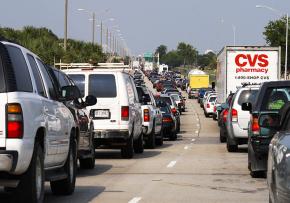Barely dodging another disaster
, a New Orleans resident who evacuated before Hurricane Gustav hit, points out that the city still remains vulnerable to more powerful storms.
NEW ORLEANS came through Hurricane Gustav with relatively minor damage compared with Katrina. But things could have been much worse if the storm had maintained its Category 3 strength when it made landfall.
As Gustav approached the Gulf Coast, New Orleans Mayor Ray Nagin said, "This will be the first real test we'll have of the federally rebuilt levees"--despite the fact that the levee projects weren't slated to be finished until 2010, a date now delayed until 2011.
That's a test New Orleans could easily fail. The repairs were meant to prepare the city for a direct hit from a storm somewhere between Category 2 and Category 3. A storm surge of 15 to 20 feet would easily top the levees, likely leading to a nightmarish repeat of the Katrina catastrophe.
As of the evening of September 1, though, Gustav's storm surge was lower than initially feared--although water did lap from the Industrial Canal into the Upper Ninth Ward, the largely African American neighborhood devastated by post-Katrina floods.

Early predictions suggested extensive flooding was possible on the West Bank, the section of New Orleans divided from the rest of the city by the Mississippi. Because Katrina caused breaches along Lake Pontchartrain, it was these levees that underwent the most scrutiny in the last three years. The West Bank levees are lower than those along the lake, and would fail should a storm surge top 7 feet. Lower-than-projected water heights from the Gustav surge, however, may have saved the West Bank from flooding.
WHILE LEVEES remain a source of concern, evacuation efforts certainly moved much better than in 2005. Yet saying that the Gustav evacuation is an improvement over Katrina is extremely mild praise.
Politicians don't want to find themselves being accused of not learning from the past, and more resources were put into evacuation planning. Even George Bush and Dick Cheney canceled appearances at the Republican National Convention so they might seem diligent in the face of Gustav.
And although the evacuation was largely successful, it wasn't without major problems. The total number of evacuees from southern Louisiana and southeast Texas could surpass 2 million--and as a result, the main interstates leading away from Gustav's path were choked with cars as early as Saturday, August 30.
The four-hour drive from New Orleans to Houston became a 10-hour-plus ordeal, and drivers moving east into Mississippi faced similar conditions. Gas stations in evacuating areas and along the paths of evacuees frequently ran out of fuel--an obvious problem apparently unforeseen by government authorities.
By Saturday afternoon, nearly every gas station along the highway between New Orleans and Houston had at least a few handwritten signs marking empty pumps. Throughout Saturday and Sunday, stations that still had gas had lines of up to 50 drivers stretching into the road.
The combination of high fuel prices and drivers burning gas idling in traffic snarls of 50 miles and more made the evacuation an extremely expensive undertaking. This was particularly true for evacuees unable to stay with nearby friends or family. Hotels are packed throughout the entire region surrounding Gustav's path.
Buses and trains took evacuees from designated points in New Orleans. These pickups were originally scheduled to end at noon on Sunday, but were extended until 3 p.m. Nearly 20,000 evacuees were taken from these departure points to shelters in northern Louisiana and Mississippi.
Nevertheless, it felt as if evacuation procedures were more about protecting property than people. Nagin and many southern Louisiana parish (county) presidents bragged about increased police protection.
St. Bernard Parish, which borders Orleans Parish to the east, is reportedly on "lockdown." A 24-hour curfew is in effect, and there are checkpoints along roads entering the parish. Since local jails are closed, the president of St. Bernard Parish said that anyone arrested there for curfew violations will be taken directly to the notorious state prison at Angola.
This overwhelming emphasis on preventing looting seems like a recipe for racial profiling. After Katrina, it was common in the media for Black hurricane victims taking food from stores to be labeled "looters," while whites doing the same thing were simply "foraging for supplies."
And while many homeowners may feel relief that their property will be protected from theft during the evacuation, people who didn't evacuate won't be getting any help from the government.
"We've changed our approach to evacuations," Nagin said. "Prior to Katrina and during Katrina, we had a shelter of last resort--the Superdome and the Convention Center. We no longer have that, so anything above a Category 2 storm, we're evacuating everybody out of the city, and we have buses, trains and planes lined up to accomplish that, and we've tested the system. We've practiced it, and we're ready to implement it."
In other words, police will be too busy protecting empty businesses and Garden District mansions, so anyone who was unable to evacuate will have no access to emergency services.
No matter how much damage is ultimately done by Gustav, this storm and its aftermath will only reemphasize the fact that the effort to rebuild New Orleans and protect the Gulf Coast from hurricanes is woefully inadequate. Had Gustav taken a path slightly farther east, it could have easily caused a disastrous Katrina repeat. Three years after that storm, the city remains a potential target for further needless destruction from a hurricane.


